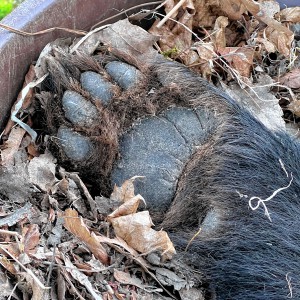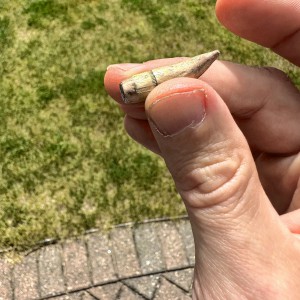Ask a (Local) Master Gardener: How do I keep my cats from eating spring seedlings?
| Published: 01-30-2020 11:33 AM |
Q: I want to get started this spring growing vegetables and lettuces in containers on my back patio. The problem is, if I’m going to start from seed, how do I keep the seedlings from being devoured by my two 20-lb indoor cats who are bound and determined to eat everything that’s not under lock and key? —Christian Feuerstein, Northampton
A: Firstly, Christian, thank you so much for the lovely photo of your adventurous feline companions, Gilbert and Sullivan (Sully). They look ready for action! You have hit on an age-old conundrum about which there are many opinions. Stepping a toe into this debate, below are some suggestions, though no guarantees. Use in combination for greater effect.
Cats like to dig, and soft soil feels so good. They like to test their pounce power. They like to eat. They like other things, too, but these traits can particularly trouble fledgling seedlings.
Let’s take three primary tactics to address these challenges: 1) deny/discourage access; 2) create a stink; and 3) provide alternatives.
This means keep seedlings out of paw reach. You will need something that air, light and water can penetrate, also something sturdy.
Birdcage: New or used. Many dimension options. Line paw-wide space between bars with mesh. Strong support in case cats climb.
Willow or chicken wire cloche: Secure to container with sturdy clips. If using deep pot, put rocks or bricks in bottom to help prevent overturning.
Compact outdoor seed starter: Like a flexible mini-greenhouse that allows airflow without requiring opening as a cold frame does. Place over top of your containers and secure. Check dimensions.
Article continues after...
Yesterday's Most Read Articles
 Holyoke man finds bear paw in his yard
Holyoke man finds bear paw in his yard
 Developer lands $400K loan for affordable housing project in Easthampton mill district
Developer lands $400K loan for affordable housing project in Easthampton mill district
 Petition to block auto dealership on King Street falters in Northampton
Petition to block auto dealership on King Street falters in Northampton
 Fearful Belchertown residents blame stray bullets on nearby gun club, appeal to town for help
Fearful Belchertown residents blame stray bullets on nearby gun club, appeal to town for help
 South Hadley man fatally shot in attempted robbery
South Hadley man fatally shot in attempted robbery
 First look at how little Amherst’s police alternative being used called troubling
First look at how little Amherst’s police alternative being used called troubling
Hang it up: Plant seedlings in a hanging basket. Rotate for full sun exposure.
Cover soil with uncomfortable-to-paws material such as crushed filbert (hazelnut) shells or chunky mulch.
Cats dislike the smell of citrus and various other aromatic plants such as rosemary, scented geranium, lavender and marigold.
Grow marigold seedlings and/or small rosemary plants in same containers as vegetables.
Surround seedlings with the above offending plants.
Toss orange and lemon peel amid the seedlings. No concentrated oil.
No chemical pesticides or herbicides. Organic seed labeled no-pesticide is optimal.
Grow more veggies than you think you will need.
Grow pots of catnip/catmint/wheat grass/oat grass especially for Sully and Gilbert. Should taste better than lettuce to them. Set away from seedlings.
Provide outdoor sandbox for digging away from seedlings. Sand feels better than mulch or shells. Just be prepared for cat litter.
Research cat-safe herbs and veggies before heading to the nursery. Assume the cats will eat some seedlings at some point and plan ahead. See the ASPCA cat plant list at www.aspca.org.
If you find the happy cat/happy plant secret formula, Christian, please let me know! I hope these ideas will help and inspire you. Thank you for asking a (local) Master Gardener.
Have a gardening dilemma? Please send questions, along with your name/initials and community, to the Western Massachusetts Master Gardener Association at AskAMasterGardener@wmmga.org. One question will be selected and answered per month. wmmga.org

 Valley Bounty: Grass-fed animals that feed the grass: Gwydyr Farm in Southampton focuses on ‘restoring the connection between land, food and people’
Valley Bounty: Grass-fed animals that feed the grass: Gwydyr Farm in Southampton focuses on ‘restoring the connection between land, food and people’ Weekly Food Photo Contest: This week’s winner: Mary Chicoine of Easthampton
Weekly Food Photo Contest: This week’s winner: Mary Chicoine of Easthampton  Speaking of Nature: A romantic evening for two birders — To hear the wonderful sounds of the Saw-whet Owl one must go outside at night
Speaking of Nature: A romantic evening for two birders — To hear the wonderful sounds of the Saw-whet Owl one must go outside at night Speaking of Nature: Where have all the birds gone?: They’re there, and here’s a handy tool to keep track of their appearances
Speaking of Nature: Where have all the birds gone?: They’re there, and here’s a handy tool to keep track of their appearances
